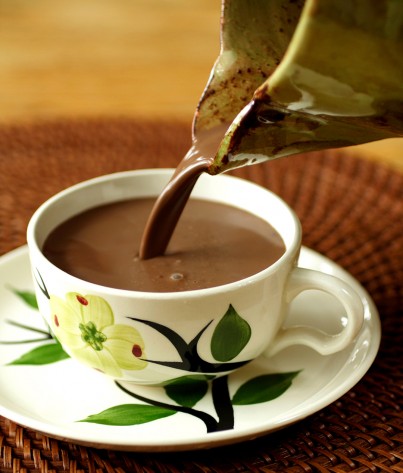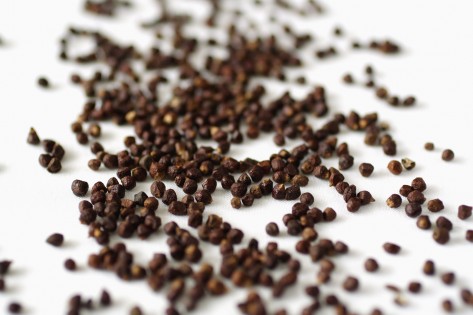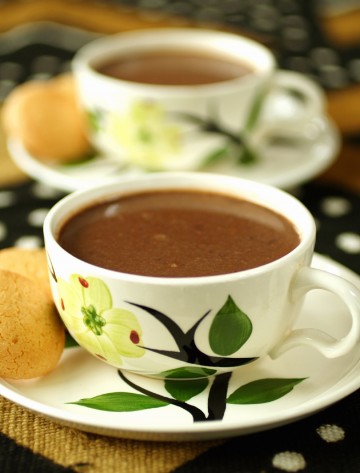African Drinking Chocolate

Grains of Paradise. This, the most poetic and beguiling of the names for melegueta, a pungent spice native to West Africa, has finally found a place in my kitchen.
I learned of grains of paradise years ago in an early colonial hearth cooking class. The instructor, clad in a period-style dress, had many antique props, one of which was an ornate wooden spice box. The fineness of its craftsmanship mirrored the wealth of the contents it would have held—spices such as grains of paradise, nutmeg, coriander, allspice, cinnamon, clove, and black pepper—and its lock and key, to which only the cook had access, secured their safekeeping.

Grains of Paradise
Charmed by its name, I purchased a small bag of grains of paradise, but never found a way to incorporate them into my cooking, even though, with their peppery bite, I could have made regular use of them as a black pepper substitute. (This was a common practice in Europe during the fourteenth and fifteenth centuries.)
Until now. Inspired by DCCC’s current pick (70 Traditional African Recipes), I developed two versions for drinking chocolate with an African twist using the small reddish-brown grains: a single-origin base and a blended base.
Though Africans consume little of the world’s chocolate production, Africa, particularly West Africa, is the world’s largest producer of cacao beans. The Côte d’Ivoire alone produces 70 percent of the world’s cacao, forming the base of much of the world’s blended chocolates ranging from Hershey’s to high quality chocolate such as Callebaut, followed by Ghana, Nigeria, and Cameroon.
 Single-origin African chocolates are also available; these are typically made with the Criollo and Trinitario cacao beans (the latter being a cross of the Criollo and Forastero), which are more finicky to grow than the Forresto—the workhorse cacao bean that is used for bulk production at the big factories like Hershey’s—but tend to be more subtle and refined in flavor. I found two single-origin examples from Lake Champlain Chocolates, a local Vermont-based company: A Sao Thome bar (70% cacao) and a Tanzania bar (75% cacao). (Lake Champlain Chocolates also offers an African Blend (80% cacao) comprised of cacao from Tanzania, Ghana, and Sao Thome.)
Single-origin African chocolates are also available; these are typically made with the Criollo and Trinitario cacao beans (the latter being a cross of the Criollo and Forastero), which are more finicky to grow than the Forresto—the workhorse cacao bean that is used for bulk production at the big factories like Hershey’s—but tend to be more subtle and refined in flavor. I found two single-origin examples from Lake Champlain Chocolates, a local Vermont-based company: A Sao Thome bar (70% cacao) and a Tanzania bar (75% cacao). (Lake Champlain Chocolates also offers an African Blend (80% cacao) comprised of cacao from Tanzania, Ghana, and Sao Thome.)
This gave me the opportunity to do two equally good but different recipes: a single-origin version with Lake Champlain Chocolates’ Tanzania bar—its bold, fruity flavor paired better with the peppery grains of paradise than their Sao Thome bar—and a less expensive version using my standard, go-to drinking chocolate base made with Dutch-processed cocoa powder and bittersweet chocolate (I use Callebaut). Because African cacao beans make their way into most chocolate, you could argue that both versions are equally African (even if made with Hershey’s!), but the Tanzanian absolutely creates a more distinctive, exotic, and one-of-a-kind drinking chocolate experience.
The opportunity to do a double-terrior themed drinking chocolate, like this one—with the cacao and the flavorings being of the place—is limited to countries that lie 10 degrees north or south of the equator, where cacao beans thrive. (See Frothed Mexican Drinking Chocolate, for another example.)
Single-Origin African Drinking Chocolate
Makes three 6-ounce servings
1½ teaspoons grains of paradise (see Notes)
2¾ cups whole milk
3 ounces Tanzanian chocolate (75% cacao), chopped (see Notes)
Small pinch of sea salt
⅛ teaspoon vanilla extract
- Coarsely grind the grains of paradise with a mortar and pestle, or by placing the grains of paradise in a bag and whacking away at them with the bottom of a heavy saucepan or rolling over them with a rolling pin.
- Combine the ground spice and milk in a small, heavy saucepan. Bring to a gentle boil over medium heat, stirring frequently. (If your saucepan has a thin bottom, heat the milk over medium-low heat.) Reduce the heat to low and simmer for 15 minutes, stirring occasionally. (If you think you may have scorched the milk, do not scrape the bottom of the pan when stirring.) Strain the milk, pressing against the sieve to extract any remaining liquid; discard the grains of paradise. The milk will have reduced by about ½ cup.
- Place the chocolate and about ¼ cup of the stained milk in the saucepan. Melt the chocolate over medium-low heat, stirring continuously until the chocolate is completely melted. Add the remaining of milk in a steady stream, while stirring. Bring to a gentle simmer, stir in the salt and vanilla, and serve.
Notes: Grains of paradise can be purchased online at The Spice House, or you may substitute some a combination of crushed whole black peppercorns and cardamom seeds. (A ratio of six to eight peppercorns to seeds from two cardamom pods is about right.) Fresh grains of paradise will have complex peppery flavor, with undertones of cardamom. Old grains of paradise will have lost its nuance and will peppery only with a bitter, acrid aftertaste.
Better quality chocolate with higher amounts of cacao solids tends to be available in bars or block form, necessitating chopping. To make sure the chocolate melts at an even rate, chop the block into small, similar-size pieces. I like chopping chocolate; however, if you can find what you want in pistoles or chips, this will eliminate a step.
Version 2: African Drinking Chocolate with a Blended Base
Makes four 6-ounce servings
1½ teapsoons grains of paradise (see Notes, above)
3½ cups whole milk
4 tablespoons Dutch-processed (alkalinized) cocoa powder
2 ounces bittersweet chocolate (52 to 55% cacao), chopped (see Notes, above)
1½ tablespoons sugar
Pinch of sea salt
Scant ¼ teaspoon vanilla extract
- Coarsely grind the grains of paradise with a mortar and pestle, or by placing the grains of paradise in a bag and whacking away at them with the bottom of a heavy saucepan or rolling over them with a rolling pin.
- Combine the ground spice and milk in a small, heavy saucepan. Bring to a gentle boil over medium heat, stirring frequently. (If your saucepan has a thin bottom, heat the milk over medium-low heat.) Reduce the heat to low and simmer for 15 minutes, stirring occasionally. (If you think you may have scorched the milk, do not scrape the bottom of the pan when stirring.) Strain the milk, pressing against the sieve to extract any remaining liquid; discard the grains of paradise. The milk will have reduced by about ½ cup.
- Place the cocoa powder in the saucepan. While stirring continuously, over medium-low heat, gradually add ¼ cup of the strained milk, a tablespoon at a time. Continue stirring until all lumps of cocoa are incorporated and the mixture is smooth.
- Add the chocolate and reduce the heat to low. Gradually add another ¼ cup of the milk, while stirring. Heat until the chocolate is melted, stirring often. Add the remaining milk in a steady stream, while stirring. Bring to a gentle simmer. Stir in the sugar, salt, and vanilla and serve.
